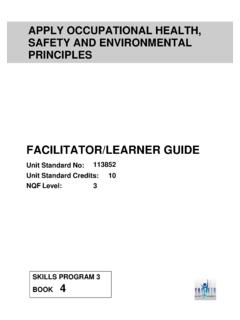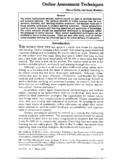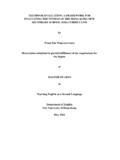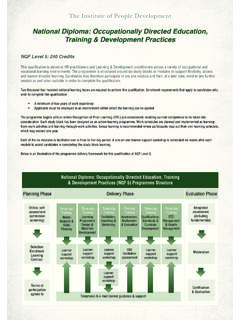Transcription of 113909 Learner guide - OSHA
1 COACH A TEAM MEMBER IN ORDER TO ENHANCE INDIVIDUAL PERFORMANCE IN A WORK ENVIRONMENT FACILITATOR/ Learner guide Unit Standard No: 113909 Unit Standard Credits: 5 NQF Level: 3 SKILLS PROGRAM 3 BOOK 1 2 3 REVIEW AND ALTERATION OF TRAINING MATERIAL What follows is a brief explanation of the process that was followed in the alteration of this training material. A working group was formed after inviting interested parties to attend a meeting at SASSETA. The working group was mandated to review the material and thereafter make the necessary changes so as to provide the industry with a more user friendly set of materials which better reflects the needs of the security industry.
2 It must be understood that this is the first review and by no means the final review. The working group was placed under enormous pressure to get a workable set of materials into the hands of the accredited security industry training providers as quickly as possible. We therefore have no doubt that even though the materials have been vastly improved upon, there are still areas that may require change. This we plan to do in the next renewal phase after we receive feedback from training providers who have used the material for approximately a year.
3 Our review process focused on the following: Removal of unnecessary information/duplication from the learning material. Ensure alignment with the unit standards. Re-draft all formative and summative assessments. Correct inappropriate use of language. TASK TEAM The task team that completed the work on this training material deserves a very special thank you , considering that all their time and efforts were provided free of charge. Nobody was paid for any of the work done on behalf of the task team.
4 SASSETA provided funding for the expenses incurred in printing, typesetting, lunch and refreshments. The task team members are as follows: Andre Pretorius International Firearm Training Academy Andre Wilken SSN Dave Dodge ESKOM Eddie Du Plooy/ Elvis Masera SBV Services Jean Du Plessis Lyttleton Firearm Training Centre Leon van Rooyen NAD Lionel Arries SASSETA (observer/adviser) Marion Colley Pexco Security and Training A very sincere thank you to all of these individuals and the companies they work for, who allowed them to participate during business hours.
5 This could not have been done without your commitment. Sincerely Andre Pretorius Task Team Chairman 4 PPRROOGGRRAAMM GGUUIIDDEE 66--77 1. Introduction 6 2. Purpose of this learning program 6 3. Standards and qualifications 6 4. Assessments 6 5. Security program matrix 7 SSttuuddyy uunniitt 11:: IInnttrroodduuccttiioonn ttoo ccooaacchhiinngg 88--1155 1. Introduction 9 2. Definitions 9 3. Basic Principles of Training 9 4. Differences between Training and Coaching 10 5. Workplace counselling 10 6. Questioning Techniques 11 7.
6 Types of questions 11 8. Coaching Alternatives 12 9. What COACHING is and is not! 12 10. Role of a Coach 13 11. Characteristics of coaching 13 12. Characteristic of the effective coach 13 13. Benefits of coaching 14 14. Criteria for successful coaching 14 SSttuuddyy uunniitt 22:: CCoommmmuunniiccaattiioonn 1166--2244 1. Objectives of communication 17 2. The communication process 17 3. Characteristics of communication 18 4. Guidelines for effective communication 19 5. Steps to ensure effective communication 19 6. Methods of communication 19 7.
7 Obstacles to communication 20 8. Listening habits 20 9. Listening skills 21 10. Positive listening habits 22 5 SSttuuddyy uunniitt 33:: TThhee ccooaacchhiinngg pprroocceessss 2255--3344 1. Need for coaching 26 2. Informal and formal coaching 26 3. Coaching opportunities 26 4. Providing remedial support 26 5. Sources of power 27 6. Coaching 28 7. The coaching process within the workplace 29 8. Coaching teams 30 9. Monitoring 30 10. Review procedure 31 11. Problems and potential solutions 34 12. Developing a coaching plan 34 SSttuuddyy uunniitt 44:: CCooaacchhiinngg sskkiillllss aanndd tteecchhnniiqquueess 3355--3388 1.
8 Prepare for coaching 36 2. Theory and knowledge 36 3. Clarify problem/expectations 36 4. Agree on solutions/action 37 5. Review and follow-up 37 6. Steps to a coaching team 38 SSttuuddyy uunniitt 55:: FFeeeeddbbaacckk 3399--4422 1. Why feedback 40 2. Reviewing and giving feedback 40 3. DO S & DON T S 41 4. Tips for effective feedback 41 5. Providing a variety of rewards 41 SSttuuddyy uunniitt 66:: EEvvaalluuaattiinngg tthhee lleeaarrnniinngg pprroocceessss 4433--4466 1. Evaluate learning processes 44 UNIT STANDARD 47-49 Learner WORKBOOK SECTION 50-56 6 1.
9 Introduction This learning program is part of a complete qualification. The qualification is General Security Practices NQF level 3. 2. Purpose of this learning program A person accredited with this unit standard will be able to: Explaining the concept of coaching in a business environment. Demonstrating skills and techniques required of a coach. Developing an action plan to coach two team members. Gathering evidence and monitoring progress. Target group This program is compiled for the following target group: Security members South African Defense Force members South African Police Force members Correctional Services Individuals who wishes to complete the NQF level 3 National Certificate in security practices.
10 3. Standards and qualifications Unit standards are the building blocks of qualifications. All qualifications are plotted on the National Qualifications Framework (NQF). Unit standards comprises of outcomes. An outcome is a statement that describes the required competency that must be demonstrated by the Learner on successful completion of a training intervention. 4. Assessments The assessment criteria describe the evidence that is needed that will show that the Learner has demonstrated the outcome correctly. Kindly refer to the unit standard attached hereto for the assessment criteria listed under each Specific Outcome in order for you to see what you will be assessed against.












